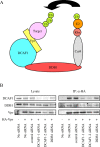Interactions with DCAF1 and DDB1 in the CRL4 E3 ubiquitin ligase are required for Vpr-mediated G2 arrest
- PMID: 24912982
- PMCID: PMC4058697
- DOI: 10.1186/1743-422X-11-108
Interactions with DCAF1 and DDB1 in the CRL4 E3 ubiquitin ligase are required for Vpr-mediated G2 arrest
Abstract
Background: HIV-1 Vpr-mediated G2 cell cycle arrest is dependent on the interaction of Vpr with an E3 ubiquitin ligase that contains damage-specific DNA binding protein 1 (DDB1), Cullin 4A (Cul4A), DDB1 and Cul4-associated factor 1 (DCAF1), and Rbx1. Vpr is thought to associate directly with DCAF1 in the E3 ubiquitin ligase complex although the exact interaction pattern of the proteins in the complex is not completely defined. The Vpr of SIVagm induces G2 arrest of cognate African Green Monkey (AGM) cells but not human cells. The molecular mechanism by which SIVagm Vpr exhibits its species-specific function remained unknown.
Methods: Physical interaction of proteins in the E3 ubiquitin ligase complex was assessed by co-immunoprecipitation followed by western blotting. In addition, co-localization of the proteins in cells was investigated by confocal microscopy. The cell cycle was analyzed by propidium iodide staining and flow cytometry. DNA damage response elicited by Vpr was evaluated by detecting phosphorylation of H2AX, a marker for DNA damage response.
Results: We show that RNAi knock-down of DCAF1 prevented the co-immunoprecipitation of DDB1 with HIV-1 Vpr while DDB1 knock-down did not influence the binding of Vpr to DCAF1. HIV-1 Vpr mutants with a L64P or a R90K mutation maintained the ability to associate with DCAF1 but did not appear to be in a complex with DDB1. SIVagm Vpr associated with AGM DCAF1 and DDB1 while, in human cells, it binds to human DCAF1 but hardly binds to human DDB1, resulting in the reduced activation of H2AX.
Conclusions: The identification of Vpr mutants which associate with DCAF1 but only poorly with DDB1 suggests that DCAF1 is necessary but the simple binding of Vpr to DCAF1 is not sufficient for the Vpr association with DDB1-containing E3 ligase complex. Vpr may interact both with DCAF1 and DDB1 in the E3 ligase complex. Alternatively, the interaction of Vpr and DCAF1 may induce a conformational change in DCAF1 or Vpr that promotes the interaction with DDB1. The ability of SIVagm Vpr to associate with DDB1, but not DCAF1, can explain the species-specificity of SIVagm Vpr-mediated G2 arrest.
Figures





Similar articles
-
Defining the interactions and role of DCAF1/VPRBP in the DDB1-cullin4A E3 ubiquitin ligase complex engaged by HIV-1 Vpr to induce a G2 cell cycle arrest.PLoS One. 2014 Feb 18;9(2):e89195. doi: 10.1371/journal.pone.0089195. eCollection 2014. PLoS One. 2014. PMID: 24558487 Free PMC article.
-
Inhibition of Vpx-Mediated SAMHD1 and Vpr-Mediated Host Helicase Transcription Factor Degradation by Selective Disruption of Viral CRL4 (DCAF1) E3 Ubiquitin Ligase Assembly.J Virol. 2017 Apr 13;91(9):e00225-17. doi: 10.1128/JVI.00225-17. Print 2017 May 1. J Virol. 2017. PMID: 28202763 Free PMC article.
-
HIV-1 Vpr loads uracil DNA glycosylase-2 onto DCAF1, a substrate recognition subunit of a cullin 4A-ring E3 ubiquitin ligase for proteasome-dependent degradation.J Biol Chem. 2010 Nov 26;285(48):37333-41. doi: 10.1074/jbc.M110.133181. Epub 2010 Sep 24. J Biol Chem. 2010. PMID: 20870715 Free PMC article.
-
Lentivirus Vpr and Vpx accessory proteins usurp the cullin4-DDB1 (DCAF1) E3 ubiquitin ligase.Curr Opin Virol. 2012 Dec;2(6):755-63. doi: 10.1016/j.coviro.2012.09.010. Epub 2012 Oct 10. Curr Opin Virol. 2012. PMID: 23062609 Free PMC article. Review.
-
The functions of the HIV1 protein Vpr and its action through the DCAF1.DDB1.Cullin4 ubiquitin ligase.Cytokine. 2010 Jul;51(1):1-9. doi: 10.1016/j.cyto.2010.02.018. Epub 2010 Mar 27. Cytokine. 2010. PMID: 20347598 Free PMC article. Review.
Cited by
-
CRL4-DCAF1 Ubiquitin Ligase Dependent Functions of HIV Viral Protein R and Viral Protein X.Viruses. 2024 Aug 17;16(8):1313. doi: 10.3390/v16081313. Viruses. 2024. PMID: 39205287 Free PMC article. Review.
-
Degradation of SAMHD1 by Vpx Is Independent of Uncoating.J Virol. 2015 May;89(10):5701-13. doi: 10.1128/JVI.03575-14. Epub 2015 Mar 11. J Virol. 2015. PMID: 25762741 Free PMC article.
-
RNA Viruses: RNA Roles in Pathogenesis, Coreplication and Viral Load.Curr Genomics. 2015 Oct;16(5):327-35. doi: 10.2174/1389202916666150707160613. Curr Genomics. 2015. PMID: 27047253 Free PMC article.
-
E3 Ubiquitin Ligases in Gammaherpesviruses and HIV: A Review of Virus Adaptation and Exploitation.Viruses. 2023 Sep 15;15(9):1935. doi: 10.3390/v15091935. Viruses. 2023. PMID: 37766341 Free PMC article. Review.
-
Reconstructing the temporal progression of HIV-1 immune response pathways.Bioinformatics. 2016 Jun 15;32(12):i253-i261. doi: 10.1093/bioinformatics/btw254. Bioinformatics. 2016. PMID: 27307624 Free PMC article.
References
-
- Balliet JW, Kolson DL, Eiger G, Kim FM, McGann KA, Srinivasan A, Collman R. Distinct effects in primary macrophages and lymphocytes of the human immunodeficiency virus type 1 accessory genes vpr, vpu, and nef: mutational analysis of a primary HIV-1 isolate. Virology. 1994;200:623–631. doi: 10.1006/viro.1994.1225. - DOI - PubMed
Publication types
MeSH terms
Substances
Grants and funding
LinkOut - more resources
Full Text Sources
Other Literature Sources
Research Materials

